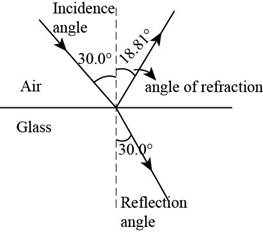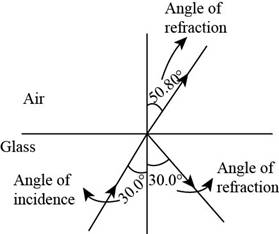
Concept explainers
(a)
The angle of the reflected and refracted rays when light ray incident from the air at angle of incidence
(a)
Answer to Problem 32AP
The angle of reflection is
Explanation of Solution
Given info: The index of refraction of glass is
From, law of reflection, the angle of incidence is equal to the angle of reflection.
Thus, angle of reflection is
From Snell’s law,
Here,
Substitute
The figure below shows the angle of incidence, the angle of reflection and the angle of refraction.

Figure (1)
Conclusion:
Therefore, the angle of reflection is
(b)
The angle of the reflected and refracted rays when light ray incident from the glass at angle of incidence
(b)
Answer to Problem 32AP
The angle of reflection is
Explanation of Solution
Given info: The index of refraction of glass is
From, law of reflection, angle of incidence is equal to angle of reflection.
Thus, angle of reflection is
From, Snell’s law,
Here,
Substitute
The figure below shows the angle of incidence, the angle of reflection and the angle of refraction.

Figure (2)
Conclusion:
Therefore, the angle of reflection is
(c)
The angles of reflection and refraction for all angles of incidence at
(c)
Answer to Problem 32AP
The angle of reflection is same as the angle of incidence and the angle of refraction for rays incident from air onto the air-glass surface is increasing as angle of incidence is increasing. The table for different values of angles is,
| Angle of incidence | Angle of reflection | Angle of refraction |
|
|
|
|
|
|
|
|
|
|
|
|
|
|
|
|
|
|
|
|
|
|
|
|
|
|
|
|
|
|
|
|
|
|
|
|
|
|
|
|
Explanation of Solution
From, law of reflection, the angle of reflection is equal to the angle of incidence. So for all value of angles between
The formula to calculate the angle of refraction is,
From, Snell’s law,
Substitute
Substitute
The remaining values of the angle of refraction can be calculated by the same method.
The table for angle of reflection and angle of refraction for all angles of incidence at
| Angle of incidence | Angle of reflection | Angle of refraction |
|
|
|
|
|
|
|
|
|
|
|
|
|
|
|
|
|
|
|
|
|
|
|
|
|
|
|
|
|
|
|
|
|
|
|
|
|
|
|
|
Conclusion:
Therefore, the angle of reflection is same as the angle of incidence and the of angle of refraction for rays incident from air onto the air-glass surface is increasing as angle of incidence is increasing.
The table for angle of reflection and angle of refraction for all angles of incidence at
| Angle of incidence | Angle of reflection | Angle of refraction |
|
|
|
|
|
|
|
|
|
|
|
|
|
|
|
|
|
|
|
|
|
|
|
|
|
|
|
|
|
|
|
|
|
|
|
|
|
|
|
|
(d)
The angles of reflection and refraction for all angles of incidence at
(d)
Answer to Problem 32AP
The angle of reflection is same as the angle of incidence and the of angle of refraction for rays coming up to the interface through the glass will increase up to angle of incidence
The table for angle of reflection and angle of refraction for all angles of incidence at
|
Angle of incidence(
(
|
Angle of reflection(
|
Angle of refraction(
|
|
|
|
|
|
|
|
|
|
|
|
|
|
|
|
|
|
|
|
|
|
|
|
|
|
|
|
|
|
|
|
|
|
|
|
|
|
|
|
|
Explanation of Solution
From, the law of reflection, angle of reflection is equal to the angle of incidence. So, for all value of angles between
The formula to calculate the angle of refraction is,
From, Snell’s law,
Substitute
Substitute
The remaining values of the angle of refraction can be calculated by the same method.
The formula to calculate the critical angle is,
Here,
Substitute
The angle of incidence is greater than
The table for angle of reflection and angle of refraction for all angles of incidence at
|
Angle of incidence(
(
|
Angle of reflection(
|
Angle of refraction(
|
|
|
|
|
|
|
|
|
|
|
|
|
|
|
|
|
|
|
|
|
|
|
|
|
|
|
|
|
|
|
|
|
|
|
|
|
|
|
|
|
Conclusion:
Therefore, the angle of reflection is same as the angle of incidence and the of angle of refraction for rays coming up to the interface through the glass will increase up to angle of incidence
The table for angle of reflection and angle of refraction for all angles of incidence at
|
Angle of incidence(
(
|
Angle of reflection(
|
Angle of refraction(
|
|
|
|
|
|
|
|
|
|
|
|
|
|
|
|
|
|
|
|
|
|
|
|
|
|
|
|
|
|
|
|
|
|
|
|
|
|
|
|
|
Want to see more full solutions like this?
Chapter 34 Solutions
Physics for Scientists and Engineers with Modern Physics
- Solve and answer the question correctly please. Thank you!!arrow_forward་ The position of a particle is described by r = (300e 0.5t) mm and 0 = (0.3t²) rad, where t is in seconds. Part A Determine the magnitude of the particle's velocity at the instant t = 1.5 s. Express your answer to three significant figures and include the appropriate units. v = Value Submit Request Answer Part B ? Units Determine the magnitude of the particle's acceleration at the instant t = 1.5 s. Express your answer to three significant figures and include the appropriate units. a = Value A ? Unitsarrow_forwardSolve and answer the question correctly please. Thank you!!arrow_forward
- Solve and answer the question correctly please. Thank you!!arrow_forwardA spiral transition curve is used on railroads to connect a straight portion of the track with a curved portion. (Figure 1) Part A v = v₁ft/s 600 ft y = (106) x³ If the spiral is defined by the equation y = (106)³, where x and y are in feet, determine the magnitude of the acceleration of a train engine moving with a constant speed of v₁ = 30 ft/s when it is at point x = 600 ft. Express your answer to three significant figures and include the appropriate units. ? a = Value Unitsarrow_forwardsolve and answer the problem correctly please. Thank you!!arrow_forward
- Solve and answer the question correctly please. Thank you!!arrow_forwardSolve and answer the question correctly please. Thank you!!arrow_forwardWhen the motorcyclist is at A, he increases his speed along the vertical circular path at the rate of = (0.3t) ft/s², where t is in seconds. Take p = 360 ft. (Figure 1) Part A 60° Ρ B If he starts from rest at A, determine the magnitude of his velocity when he reaches B. Express your answer to three significant figures and include the appropriate units. v = Value Submit Request Answer ་ Part B ? Units If he starts from rest at A, determine the magnitude of his acceleration when he reaches B. Express your answer to three significant figures and include the appropriate units. 11 ? a = Value Unitsarrow_forward
- The car starts from rest at s = 0 and increases its speed at a₁ = 7 m/s². (Figure 1) Part A = 40 m Determine the time when the magnitude of acceleration becomes 20 m/s². Express your answer to three significant figures and include the appropriate units. ? t = Value Units Part B At what position s does this occur? Express your answer to three significant figures and include the appropriate units. s = Value Submit Request Answer ? Unitsarrow_forwardSolve and answer the question correctly please. Thank you!!arrow_forwardSolve and answer the question correctly please. Thank you!!arrow_forward
 Principles of Physics: A Calculus-Based TextPhysicsISBN:9781133104261Author:Raymond A. Serway, John W. JewettPublisher:Cengage Learning
Principles of Physics: A Calculus-Based TextPhysicsISBN:9781133104261Author:Raymond A. Serway, John W. JewettPublisher:Cengage Learning Physics for Scientists and Engineers: Foundations...PhysicsISBN:9781133939146Author:Katz, Debora M.Publisher:Cengage Learning
Physics for Scientists and Engineers: Foundations...PhysicsISBN:9781133939146Author:Katz, Debora M.Publisher:Cengage Learning An Introduction to Physical SciencePhysicsISBN:9781305079137Author:James Shipman, Jerry D. Wilson, Charles A. Higgins, Omar TorresPublisher:Cengage Learning
An Introduction to Physical SciencePhysicsISBN:9781305079137Author:James Shipman, Jerry D. Wilson, Charles A. Higgins, Omar TorresPublisher:Cengage Learning Physics for Scientists and EngineersPhysicsISBN:9781337553278Author:Raymond A. Serway, John W. JewettPublisher:Cengage Learning
Physics for Scientists and EngineersPhysicsISBN:9781337553278Author:Raymond A. Serway, John W. JewettPublisher:Cengage Learning Physics for Scientists and Engineers with Modern ...PhysicsISBN:9781337553292Author:Raymond A. Serway, John W. JewettPublisher:Cengage Learning
Physics for Scientists and Engineers with Modern ...PhysicsISBN:9781337553292Author:Raymond A. Serway, John W. JewettPublisher:Cengage Learning University Physics Volume 3PhysicsISBN:9781938168185Author:William Moebs, Jeff SannyPublisher:OpenStax
University Physics Volume 3PhysicsISBN:9781938168185Author:William Moebs, Jeff SannyPublisher:OpenStax





